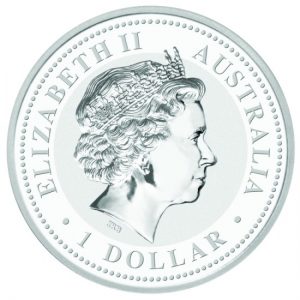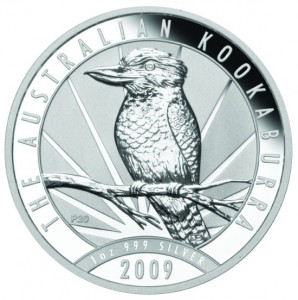Australian Silver Kookaburra
The Australian kookaburra bullion pieces are amongst the most popular bullion coins minted in Australia, rivalled only by the silver kangaroos and silver koala bullion coins. They are highly collectible due to their ever changing imagery and always sell on the secondary market for well over spot price. Whether purchasing as a collector, or simply as an investor, the Aussie kookaburra coins are a fantastic addition to any collection.
How To Buy Silver Kookaburras
The Perth Mint website where the coins are produced, includes an online store so you can buy Silver Kookaburras and other silver and gold coins directly from the source. Prices are given in both U.S. dollars and Australian dollars, and a few clicks of the mouse and keyboard can complete an order for the Silver Kookaburra or any of the other fine silver and gold coins minted by the institution.
Furthermore, the Perth Mint has a page of authorized distributors for its coins, who are located in 27 of the world’s nations. Some of these, like France, Germany, and the United States, are to be expected, but there are also authorized distributors in the Ukraine, Israel, Bulgaria, Latvia, and the Far East. Both the mint itself and the distributors are likely to have only the most recent releases in stock, however, due to high demand and the full mintage selling out quickly.
If you are looking for Silver Kookaburras from previous years, then sites like APMEX (the American Precious Metals Exchange) are your best bet for acquiring them.


Australian Kookaburra Silver Coin – P-2009 Version.
Characteristics of Australian Silver Kookaburras
Australian Silver Kookaburras are all produced by the Perth Mint, and, like many collectible bullion coins, feature a different image on the reverse each year to make them more interesting and attractive to collectors. The same reverse design has never appeared twice, though various examples of the four species of kookaburras found in Australia are always featured in some pose.
The Perth Mint is a highly skilled, up to date facility, and the superb production values of the Silver Kookaburra amply demonstrate their competence. Like most silver bullion coins, these are 99.9% pure silver (or, to express it differently, have a .999 fineness). Either 300,000 or 350,000 uncirculated bullion Kookaburras are minted annually, depending on the year, as well as a much smaller, but highly variable, number of proof coins.
The Silver Kookaburra comes in four weights, which are rather different than the weights offered for many of the world’s silver coins. Many coins offer 1 troy ounce as the standard, as well as fractional silver coins for other collectors – for example, ¼ ounce and ½ ounce coins. The Silver Kookaburra does not come in fractional sizes, however. Instead, it comes in 1 ounce, 2 ounce, 10 ounce, and 1 kilogram (around 30 ounces) sizes.
The nominal face values of the coins are $1, $2, $10, and $30 Australian, though the first few one ounce coins struck in 1990 were paradoxically given the face value of $5 Australian. All of the coins except the one troy ounce coin were originally issued in a proof only format, for the first few years of the coins’ existence, but the larger sizes are currently minted in an ordinary bullion form as well, and have been for many years.
The one ounce Silver Kookaburras are minted in a very standard size – 1 ½ inches in diameter (40.6 mm) and a typical thickness as well. The edges are reeded on all issues thus far. The mintmark P appears on some of the coins, indicating the Perth Mint.
All of the Silver Kookaburras have the image of Queen Elizabeth II on the obverse, though the age of the queen as shown on the coinage varies depending on the year of mintage. The earlier coins show a very youthful Elizabeth, while the later ones depict a middle aged monarch with a bit of a smirk on her lips, as seems to be the case with Australian coins. The earliest obverse also bears the legends “Elizabeth II”, “5 Dollars”, and “Australia”, while more recent coins state “Elizabeth II – 1 Dollar – Australia”.
The reverse of the Silver Kookaburra bears the image of a kookaburra, posed differently for each year (looking at a spider-web, paired, flying, and so on). The legend “The Australian Kookaburra” appears on the border of the coin, while the year is imprinted somewhere on the reverse and the legend “1 Oz 999 Silver” is also inscribed, though often in miniscule lettering.
The Minting History of the Australian Silver Kookaburras
Australia has been both blessed and cursed with an extremely unusual, and at times wondrous, set of animals unlike those found anywhere else on Earth. The island continent is home to the highly engaging wombats, koalas, echidnas, and platypuses, as well as the extremely distinctive kangaroos which are among the most well known beasts of the world to schoolchildren everywhere across the globe. On the other hand, Australia also sports more species of lethally poisonous animals than any other area of the world, as well. Snakes, spiders, and even octopuses are distinctively venomous.
The kookaburra is one of Australia’s notable birds. This huge kingfisher, as big as a northern hemisphere raven or a small to medium-sized hawk, is highly carnivorous and does not limit itself to fish. It will kill and eat the young of other birds, lizards, snakes, and will even assail, kill, and devour finches at times, though the finches are usually elusive enough to avoid a kookaburra attack. The feathers of the kookaburra are as spectacular as kingfisher feathers usually are, and with its loud, insane laughing call, it is no surprise that it is another well known symbol of Australia.
The Perth Mint, which has produced Silver Kookaburras since 1990 as one of their annual silver coin offerings, is the oldest continuously operating mint in Australia. Opened in the last year of the 19th century, the Perth Mint has a rather peculiar history. Australia gained its independence from direct British rule in 1901, yet the Perth Mint remained under the control of the British government, and made English currency rather than Australian coinage for another 69 years.
The Perth Mint eventually turned to making silver and gold coins for sale to the general public. This occurred during the 1980s, when governments all over the world began to sell off their gold and silver stocks to the eager buyers who wanted to hedge against economic problems by acquiring their own private reserves of these valuable substances. One of the motifs they soon turned too was the kookaburra, and the popularity of the coins ensured the series’ survival for the last twenty one years.

